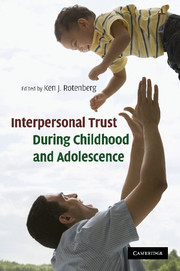Book contents
- Frontmatter
- Contents
- List of figures
- List of tables
- List of contributors
- Section I Conceptual foundations and issues
- Section II Childhood
- Section III Adolescence and early adulthood
- 10 Trust, but verify: Knowledge, disclosure, and mothers' beliefs about adolescents' trustworthiness
- 11 The role of trust in adolescent–parent relationships: To trust you is to tell you
- 12 A new scale for the assessment of adolescents' trust beliefs
- 13 A friend in need is a friend indeed: Exploring the relations among trust beliefs, prosocial tendencies, and friendships
- 14 Promoting intergroup trust among adolescents and young adults
- Index
- References
12 - A new scale for the assessment of adolescents' trust beliefs
Published online by Cambridge University Press: 04 August 2010
- Frontmatter
- Contents
- List of figures
- List of tables
- List of contributors
- Section I Conceptual foundations and issues
- Section II Childhood
- Section III Adolescence and early adulthood
- 10 Trust, but verify: Knowledge, disclosure, and mothers' beliefs about adolescents' trustworthiness
- 11 The role of trust in adolescent–parent relationships: To trust you is to tell you
- 12 A new scale for the assessment of adolescents' trust beliefs
- 13 A friend in need is a friend indeed: Exploring the relations among trust beliefs, prosocial tendencies, and friendships
- 14 Promoting intergroup trust among adolescents and young adults
- Index
- References
Summary
You may be deceived if you trust too much, but you will live in torment if you do not trust enough.
Frank CraneTrust is a key ingredient in the formation and maintenance of healthy interpersonal relationships. According to Rotter (1967), trust is “an expectancy held by an individual or group that the word, promise, or written statement of another individual or group can be relied upon” (p. 651). Interpersonal trust holds a prominent place in theoretical models of development. Erikson described the key developmental task of infancy as that of learning to see others as trustworthy (Erikson, 1963). The infant's trust in the caregiver is believed to be one of the primary bases in the formation of the attachment bond (Bowlby, 1979). Trust remains important across the life-span. Building a new relationship rests, in part, upon the partners' joint ability to trust the other as they engage in a process of reciprocal disclosure of thoughts, feelings, and life experiences (Rempel, Holmes, and Zanna, 1985). Maintenance of relationships also rests upon trust; relationship disintegration frequently results from either a lack of trust (e.g., romantic jealousy) or an outright betrayal of trust (e.g., infidelity) (Collins and Read, 1990; Feeney, 2005; Mikulincer, 1998). Given the significance of trust in the life-course of the individual, continued empirical research charting the developmental progression of interpersonal trust is necessary.
- Type
- Chapter
- Information
- Interpersonal Trust during Childhood and Adolescence , pp. 247 - 269Publisher: Cambridge University PressPrint publication year: 2010
References
- 5
- Cited by



